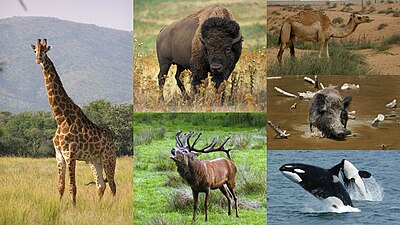
Artiodactyla is an order of placental mammals composed of even-toed ungulates – hooved animals which bear weight equally on two of their five toes with the other toes either present, absent, vestigial, or pointing posteriorly – as well as their descendants, the aquatic cetaceans. Members of this order are called artiodactyls. The order is sometimes named Cetartiodactyla, in reference to the inclusion of cetaceans in the order beginning in the 1990s.[1] Artiodactyla currently comprises 349 extant species, which are grouped into 132 genera. Artiodactyls live on every major landmass and throughout the oceans and in a variety of habitats, including forests, grasslands, and deserts. They come in a wide array of body plans in contrasting shapes and sizes, ranging from the 38 cm (15 in) long and 2.5 kg (5.5 lb) royal antelope to the 27 m (89 ft) long and 120 ton blue whale. Some artiodactyls, such as cattle, goats, sheep, pigs, water buffalo, camels, llamas, yaks, and gayals, have been domesticated, resulting in a worldwide distribution and population sizes for some animals of over one billion.
Artiodactyla is divided into four suborders: Ruminantia, Suina, Tylopoda, and Whippomorpha. The suborders are further subdivided into clades and families. Ruminantia contains six families, Antilocapridae, Bovidae, Cervidae, Giraffidae, Moschidae, and Tragulidae, and includes ruminant animals such as cattle, antelope, deer, and sheep. Suina contains two, Suidae and Tayassuidae, and includes pigs and peccaries; Tylopoda comprises only Camelidae, the camels and llamas; and Whippomorpha contains fourteen, Balaenidae, Balaenopteridae, Cetotheriidae, Delphinidae, Iniidae, Kogiidae, Lipotidae, Monodontidae, Phocoenidae, Physeteridae, Platanistidae, Pontoporiidae, Ziphiidae, and Hippopotamidae, and includes the aquatic whales and dolphins as well as hippopotamuses. The exact organization of the species is not fixed, with many recent proposals made based on molecular phylogenetic analysis. Three species have gone extinct since 1500 CE: the aurochs and the bluebuck in Bovidae and Schomburgk's deer in Cervidae. Additionally, the red gazelle in Bovidae is considered either extinct or to have never existed; the kouprey in Bovidae is potentially extinct, with no sightings since 1969; and so is the baiji in Lipotidae, last seen in 2002. Several other species are extinct in the wild or critically endangered.